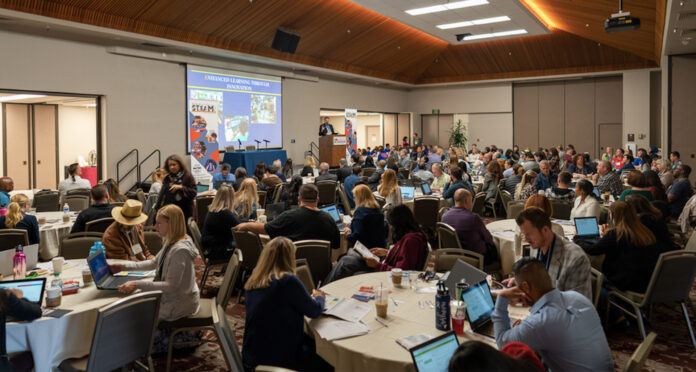C-STEM center works to close achievement gap in mathematics education
The UC Davis Center for Integrated Computing and STEM Education (C-STEM) organized the 2020 Symposium on Integrated Computing and STEM Education on Feb. 24 in collaboration with the Redlands Unified School District and the University of Redlands. One hundred and thirty students, teachers, administrators and professors shared their experiences and participated in hands-on training to learn ways to integrate coding and robotics into mathematics education. This one-day event was held at the University of Redlands.
Both entertaining and effective in capturing the interests of students, robots are useful tools for closing the achievement gap in mathematics education. C-STEM develops new and interactive curricula to teach algebra, mathematics and programming. These technologies are particularly effective in reaching students who lack interest in or struggle with mathematics and are already being used in elementary, middle and high schools throughout the country.
“[C-STEM] is a coding and robotics program focused on helping students better understand their core concepts in math, science, engineering, computer science and robotics,” said Daniel Ryan, the education service manager for C-STEM.
All software and curricula created by C-STEM are available on their website for educators to use. Additionally, the center organizes symposiums, professional development classes for educators and summer camps for students in various locations.
A full program of the events offered at the latest symposium is available on C-STEM’s website. Highlights from the event included speeches from Tim Taylor, the keynote speaker and an executive director for the Small School District Association, the C-STEM superintendents plenary panel session and the C-STEM teachers plenary panel session. There were also 16 breakout sessions and a “makerspace” for attendants to explore the robots.
“We put on a number of different breakout sessions to introduce various K-12 teachers and educators to the C-STEM program and different strategies and options for integrating more computer programming and robotics into their classrooms,” Ryan said.
Strategies suggested to educators included using computer programs to solve systems of linear equations and having students create their own dynamic robot systems.
One main goal of the symposium was to show educators how easy it is to integrate computer science into core K-12 classes. Many teachers originally are hesitant and cautious about the technologies, as many are not really familiar with computer science, Ryan said.
“There’s this misconception [computer science] is a bunch of geniuses that sit and program all day, and you have to know your stuff in order to do it,” Ryan said. “We were trying to raise awareness that really anybody can get into coding. It’s a really simple easy thing to do, it’s just a matter of being able to transcribe instructions into very, very step-by-step algorithmic
logic.”
Every fall for the last nine years, C-STEM has hosted a similar symposium in Davis. After two years of integrating C-STEM’s educational tools into their curriculum, Redlands Unified School District wanted to host a symposium in Southern California for more educators to attend. Redlands Unified School District served as a model of how the programs could be implemented, said Harry Cheng, a professor of mechanical and aerospace engineering and the director of the C-STEM program.
“The timing was perfect to expand [C-STEM programs] to all our schools, and now that we have it at all our schools, we wanted to have a Southern California symposium so that all our teachers, administrators and other school districts could attend to see our model of implementation,” said Deepika Srivastava, the STEAM and innovation coordinator for Redlands Unified School District and one of the organizers of the symposium.
Beginning computer science education, through programs like C-STEM, as early as elementary school is important to ensure all students have equitable opportunities later on in their academic and professional careers. STEM education is the biggest equalizer in terms of knowledge and preparedness for college and future careers, Srivastava said.
“It just opens a whole new world of opportunities for our students,” Srivastava said. “We just want to make sure that all our students have the opportunity to be successful in math and that we are not leaving any student behind.”
Redlands Unified School District is committed to providing these equitable learning opportunities for math and computer science education to all students, Srivastava said.
“The symposium validated our own fundamental belief that every kid can be successful in math, no matter where they come from and how they currently feel about their math preparedness,” Srivastava said. “C-STEM has brought joy back in the math classroom and has rejuvenated our students and teachers.”
Additionally, hands-on learning with robots and computer programing can help bridge the math achievement gap by bringing concepts to life. These technologies provide tangible mathematical models that help students understand and bring meaning to abstract concepts, Ryan said.
“In a lot of math classes, students are constantly asking, ‘Why are we doing this? When are we ever going to use this? Why do I need to be able to solve for X in this abstract equation?’” Ryan said. “But with hands-on learning, you’re able to say ‘Alright, this is representative of something in front of you.’”
These technologies and new approaches to education have proven to help students succeed and help close the math achievement gap. For example, a school within the Orange County Unified School District saw a 37% increase in their mathematics scores in the “Smart Balance Test” after implementing these technologies for only four years, Cheng said.
Additionally, 100% of students scoring very low on standardized mathematics tests who are English learners or have parents that recently moved to the U.S. pass their classes after working with these new technologies, according to Cheng.
“That’s how we’re using the math to close that gap,” Cheng said. “We have evidence that hands-on learning actually works great.”
Written by: Margo Rosenbaum — science@theaggie.org





